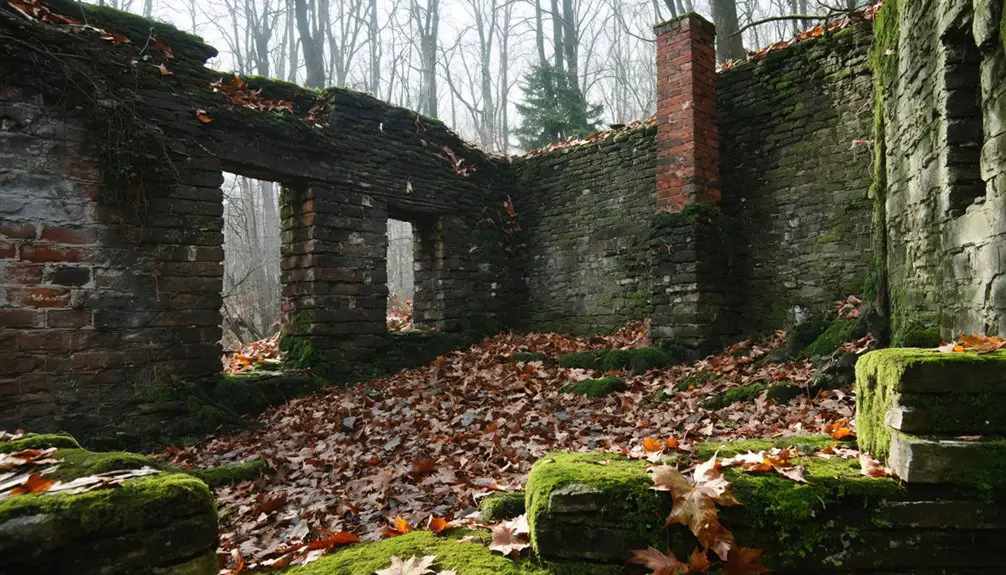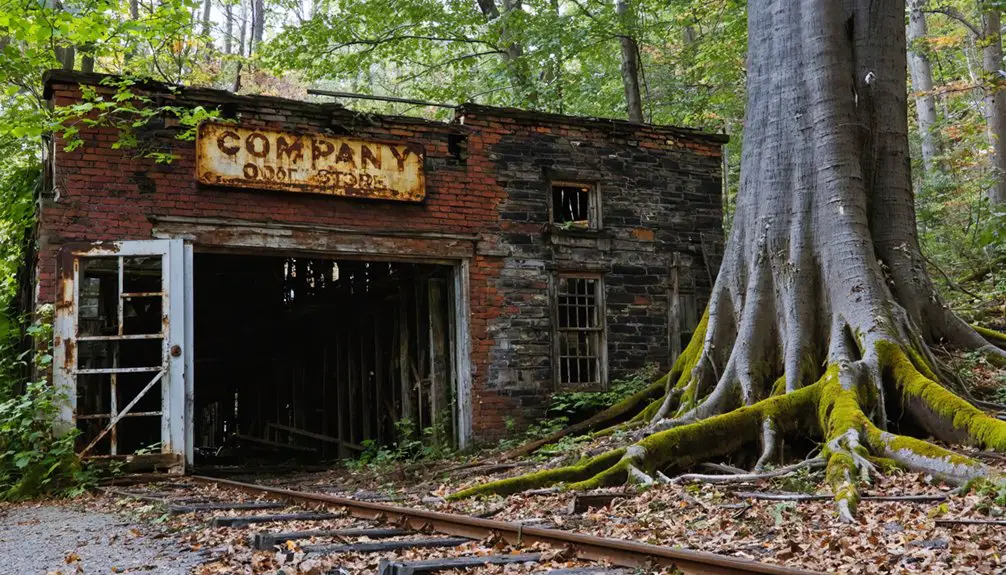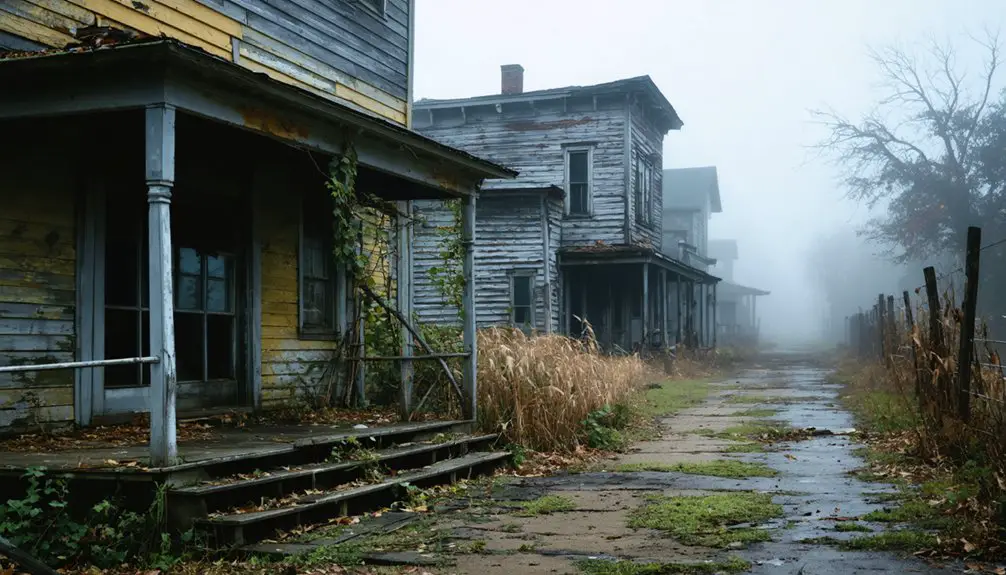You’ll find Keel Run nestled in Pennsylvania’s Allegheny Mountains, where it evolved from a logging settlement to a coal mining town in the 1860s. The Kehley Run Colliery extracted anthracite coal and employed immigrant workers who earned about $2-3 daily. The town thrived until 1931, when the mines closed and residents abandoned their homes. Today, scattered ruins, mine waste piles, and LIDAR-visible foundations tell a deeper story of this vanished community.
Key Takeaways
- Keel Run transformed from a logging settlement to a coal mining town before becoming abandoned following economic decline in 1931.
- The community was controlled by mining companies, with workers earning $2-3 daily while living in company-owned housing.
- Archaeological evidence includes deteriorating foundations, railroad traces, and mining waste dumps visible through LIDAR imaging.
- The Pennsylvania Railroad’s Bellwood Division and Bell’s Gap Railroad were crucial transportation networks serving the mining operations.
- The site lacks official preservation status and protection, with minimal community engagement to preserve its historical legacy.
Origins and Early Settlement
As dense forests and mountainous terrain characterized Western Pennsylvania’s Allegheny region, Keel Run emerged as a settlement driven by natural resource extraction.
You’ll find that early logging practices dominated the area’s economy, with scattered cabins and camps dotting the rugged landscape before 1900.
The settlement took shape around Keel Run creek, which provided both resources and transportation access through the challenging terrain. The valuable white pine timber was harvested extensively and floated downstream to Williamsport for processing.
While logging practices initially attracted seasonal workers, you wouldn’t have found many permanent structures except for a schoolhouse that operated briefly from 1900 to 1906. Much like in Centralia, small-scale mining operations gradually established themselves in the region.
Despite seasonal logging workers passing through, Keel Run remained sparsely settled, with only a short-lived schoolhouse marking permanent civilization.
The early settlements remained minimal until the Pennsylvania Railroad’s Bellwood Division extended into the area, marking a significant turning point that would soon transform Keel Run from a logging outpost into a coal mining community.
The Logging Era Legacy
The logging industry shaped Keel Run’s early identity through distinctive methods and tools that you’d find common across Western Pennsylvania’s timber regions.
You’d see skilled crews working six-day weeks with axes and crosscut saws, felling massive white pine and hemlock before winter’s arrival. They’d transport logs downstream via Pine Creek and its tributaries, using splash dams to navigate smaller waterways. The camp boss maintained order and ensured proper food quality to keep worker morale high. Workers lived in basic temporary shacks that could be quickly moved as logging operations changed locations.
As logging practices evolved, you’d witness the shift from manual labor to steam-powered sawmills and railroad networks.
While this brought economic prosperity, it also led to significant ecological consequences. The clear-cutting of virgin forests forever changed the landscape, leaving behind abandoned mills and stripped lands.
Today, you’ll find these environmental footprints as silent reminders of Keel Run’s once-thriving timber industry.
Rise of Coal Mining Operations
While the logging industry dominated Keel Run’s early years, coal mining emerged as the region’s economic powerhouse when the Kehley Run Colliery began operations in 1864.
On lands owned by the Girard Estate, you’d find miners extracting valuable anthracite coal, prized for its high carbon content. You can trace the colliery’s name to Peter Kehley, an early settler whose namesake stream provided essential water to the operation. The mine’s proximity to a nearby grocery store and recreational areas would later shape community development. The early coal mines primarily supplied blacksmith shops and local forges throughout the 1790s.
Miners at Girard Estate dug deep for anthracite, guided by Peter Kehley’s legacy and the flowing waters that sustained them.
- Peak production reached 151,000 tons of anthracite in the late 1870s
- Immigrant workers, mainly from Europe, formed the backbone of the labor force
- Two major mine fires disrupted operations, with the first striking in July 1880
- Labor disputes led to strikes and negotiations over mining rates
- Railroad and canal networks connected Kehley Run’s coal to industrial markets
Transportation and Railroad Connections
Moving coal from Keel Run’s mines required sophisticated rail networks, and you’ll find the Pennsylvania Railroad’s Bellwood Division at the heart of this transportation story.
The original Bell’s Gap Railroad, starting as a narrow gauge line in Bellwood, evolved to connect Keel Run’s coal operations to major markets. You’ll see remarkable railroad engineering throughout the route, where tracks follow river valleys and mountain contours to maintain manageable grades below 2%. The company’s commitment to conservative business practices ensured careful planning and sustainable expansion of these vital coal transport lines. Under the leadership of J. Edgar Thomson, the railroad managed an impressive network of 6,000 miles of track that facilitated efficient coal transport.
The coal transport system linked Keel Run to bustling industrial centers through an intricate network of standard and narrow gauge lines.
When you trace these rail connections, you’ll discover how they connected through Hillman and Punxsutawney, eventually feeding into the main line that ran from Philadelphia to Pittsburgh via Harrisburg and Altoona.
Daily Life in the Mining Community
Life in Keel Run revolved entirely around the mining company’s iron grip, where workers found themselves bound to a feudal-like system of company housing, stores, and medical care.
You’d spend your days hand-loading coal for about 38 cents per ton, often producing 10 tons daily before facing numerous deductions from your $3.80 earnings. Community events and social gatherings were strictly controlled within the hierarchy of the mining town’s social structure. The dangerous working conditions meant miners earned $2 to $3 daily while battling underground fires and toxic gases. The United Mine Workers of America fought to improve conditions through violent labor disputes across Pennsylvania’s coalfields.
- You’d live in company housing, paying $6 monthly rent from your $20 weekly wage
- You’d shop at company stores, cycling your earnings back to your employer
- You’d rely on company doctors, with medical fees automatically deducted from your pay
- Your social status would be reflected in your housing location and job role
- You’d find your immigrant neighbors clustering in distinct sections of the community
Economic Decline and Abandonment
As devastating mine fires ravaged Kehley Run Colliery in 1880, Keel Run’s economic foundation began to crumble.
You’d have witnessed the Thomas Coal Company struggling with mounting legal battles and firefighting costs, while competing firms like Kohinoor Company challenged their operations.
Despite the community’s resilience, court-ordered interventions and ownership disputes fractured effective management of the mines.
The economic challenges intensified as Pennsylvania’s anthracite industry declined in the early 1900s.
You’d have seen investors withdrawing their support, credit drying up, and miners facing uncertain futures.
The rise of bituminous coal elsewhere and new technologies reduced labor demands, accelerating the town’s downturn.
When larger operations like the Rolling Mill Mine closed by 1931, Keel Run’s fate was sealed, leading to widespread abandonment.
Remnants and Archaeological Evidence

You’ll find few intact structures at Keel Run today, with most physical remnants consisting of deteriorating foundations and building footings obscured by decades of overgrowth.
Railroad infrastructure traces and altered terrain from mining operations provide clear evidence of the site’s industrial past, visible in both ground surveys and LIDAR imaging.
The presence of coke oven ruins and coal mining artifacts, though limited, aligns with similar ghost town sites across Western Pennsylvania’s former mining regions.
Physical Site Features Today
Today’s remnants of Keel Run ghost town reveal themselves primarily through LIDAR imagery and scattered archaeological evidence.
Through archaeological methods, you’ll find stacked stone foundations and building footprints that outline the former settlement patterns along the main street.
Coal mining and logging operations have left lasting impressions on the landscape, with visible depressions from collapsed mine entrances and waste piles near the #1 Drift mine.
- Clear foundation outlines visible through LIDAR show former residential layouts
- Scattered stone and brick footings mark community building locations
- Former railroad alignments appear as linear clearings through forested areas
- Mining waste dumps and spoil piles create distinct terrain features
- Surface artifacts include ceramics, glass shards, and metal fragments from daily life
Mining Infrastructure Traces
The remnants of Keel Run’s mining infrastructure tell a complex story of early 20th-century coal extraction methods.
You’ll find evidence of the extensive room-and-pillar mining system in the abandoned drift mine workings near Bear Run railroad. The site reveals foundations of significant structures – power houses that once generated electricity for underground operations, fan houses that provided essential ventilation, and tipples where coal was loaded onto rail cars.
Looking closely, you can spot the remains of coal processing areas, including breaker foundations and slate picking platforms.
Large culm banks of mine waste still dominate parts of the landscape. Near the old drift entrance, you might discover traces of mule barns where animals, crucial to underground haulage, were once stabled.
Regional Ghost Town Comparisons
If you look at Pennsylvania’s abandoned mining settlements, you’ll find that Keel Run shares patterns with nearby ghost towns like Centralia and Lausanne, though on a much smaller scale.
While Centralia’s dramatic mine fire and Lausanne’s bustling tavern-and-sawmill complex left clear historical traces, Keel Run’s minimal infrastructure reflected its origins as a temporary logging camp that briefly shifted to coal mining.
The sparse remains of these ghost towns tell a common story of boom-and-bust resource extraction, with Keel Run’s single schoolhouse and minimal railway connection contrasting sharply with Centralia’s more developed town layout and Lausanne’s commercial establishments.
Mining Settlement Patterns
During Pennsylvania’s coal mining boom of the mid-to-late 19th century, towns like Keel Run emerged rapidly as companies established operations near valuable coal deposits.
These company towns followed distinct patterns, with immigrant labor living in uniform housing blocks near industrial facilities. You’ll find the settlements were carefully planned around mine entrances, with essential infrastructure strategically positioned for maximum efficiency.
- Mine entrances and drift mines formed the heart of the settlement
- Railroad branches dictated town expansion and coal transport routes
- Support facilities clustered near mines included powerhouses, tipples, and mule barns
- Worker housing was built in dense, uniform blocks reflecting company control
- Topography and underground workings constrained settlement growth patterns
Abandoned Town Infrastructure
Abandoned coal towns across Pennsylvania’s mining region share distinctive patterns of infrastructural decay, with Keel Run mirroring similar deterioration seen in nearby Centralia and Sidney.
You’ll find crumbling abandoned structures where schools, churches, and municipal buildings once stood proud, their roofless remains scattered along former rail corridors of the Pennsylvania Railroad’s Bellwood Division.
The town’s basic services disappeared quickly after its desertion, leaving behind a web of deteriorating roads that nature’s now reclaiming.
Community decay accelerated as utilities were cut off and maintenance ceased. While some roadways persist, they’re often unsafe or rerouted, much like Centralia’s Route 61.
What’s left is a skeleton of the original town layout – isolated buildings and ruins connected by vanishing streets, all slowly returning to wilderness.
Historical Preservation Status

Unlike many historic ghost towns in Pennsylvania, Keel Run lacks any official preservation status or protection. You won’t find it listed on the National Register of Historic Places or recognized by state preservation programs. The site faces significant preservation challenges due to minimal community engagement and the absence of organized conservation efforts.
- No historical markers or protective fencing exist to commemorate the site
- The land has largely reverted to state game lands without historic preservation oversight
- Unlike Centralia and Yellow Dog Village, Keel Run hasn’t attracted preservation funding
- No local groups maintain or promote the site’s historical significance
- Archaeological studies and formal documentation of remaining structures are non-existent
The area’s shift from logging to coal mining has left few visible remnants, and without official protection, Keel Run’s historical legacy continues to fade into obscurity.
Frequently Asked Questions
Are There Any Dangerous Mine Shafts or Unstable Ground Around Keel Run?
Like deadly serpents lying in wait, old mine shafts dot Keel Run’s landscape. You’ll face serious mine safety risks from toxic gases, unstable ground, and 350-foot vertical drops around Superior mines.
What Wildlife Species Now Inhabit the Abandoned Keel Run Area?
You’ll find remarkable wildlife diversity, from white-tailed deer and red foxes to barred owls and timber rattlesnakes. These species have adapted well to the abandoned town’s mix of forest and ruins.
Can Visitors Legally Explore and Photograph the Keel Run Site Today?
You can explore the site with caution since it’s on public game lands, but legal restrictions may apply. You don’t need photography permits, but should remain alert for hazards and respect preservation guidelines.
Were There Any Significant Accidents or Disasters in Keel Run’s History?
You won’t find any documented significant accidents or disasters in Keel Run’s history. Unlike other Pennsylvania mining towns that experienced major catastrophes, historical records don’t reveal any notable tragedies in this small settlement.
Does Anyone Still Own Private Property Within the Former Keel Run Settlement?
You’ll find it’s unclear if private property exists within Keel Run’s boundaries today. Most of the historically significant area overlaps with State Game Lands 174, though undocumented private parcels could remain.
References
- http://ironequine.com/history-bits/history-of-sidney-keal-run-lochvale-pennsylvania/
- https://indianacountyparks.org/our-trails/ghost-town-trail/ghost-town-trail-history/
- https://www.youtube.com/watch?v=Qj5LjacccJ0
- https://uncoveringpa.com/visiting-centralia
- https://en.wikipedia.org/wiki/List_of_ghost_towns_in_Pennsylvania
- https://pabucketlist.com/the-rise-and-fall-of-centralia-pas-toxic-ghost-town/
- https://lumberheritage.org/heritage/warren-county-lumber-history/
- https://www.youtube.com/watch?v=p4ohbPMvaxE
- https://usgennet.org/usa/pa/county/lycoming/history/Chapter-46.html
- https://www.youtube.com/watch?v=IlkjdnWSvIo



